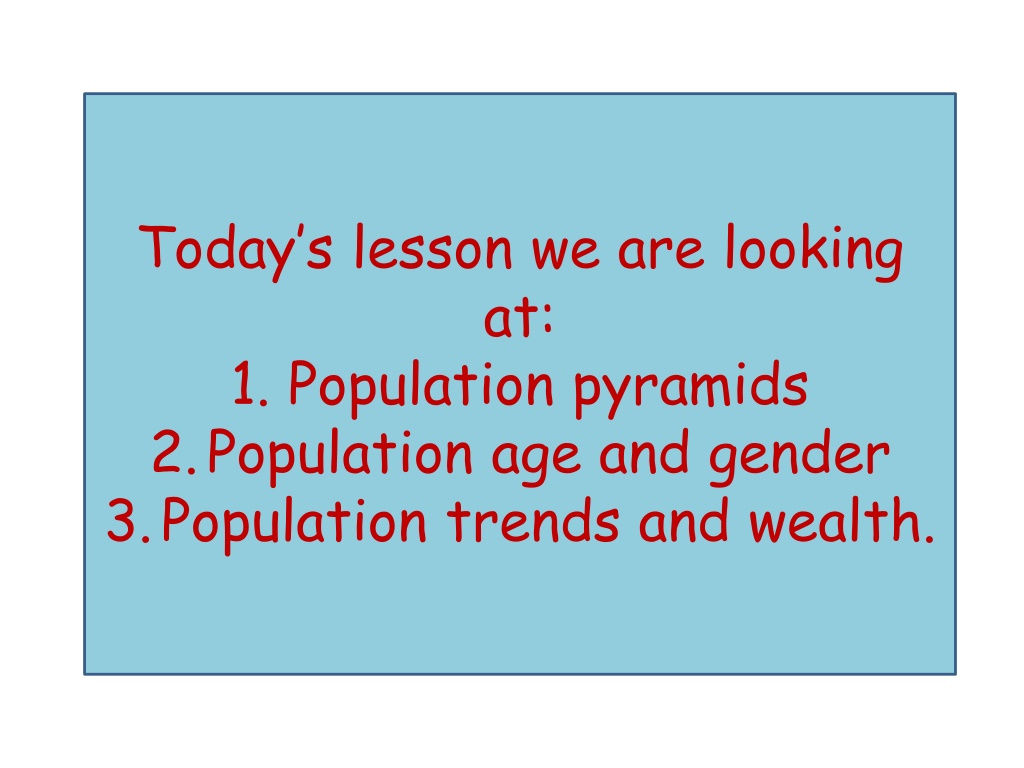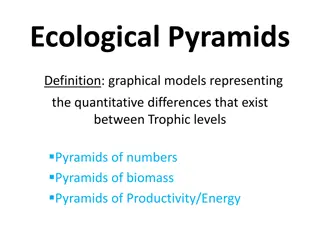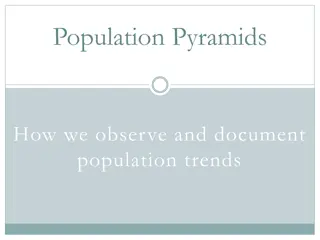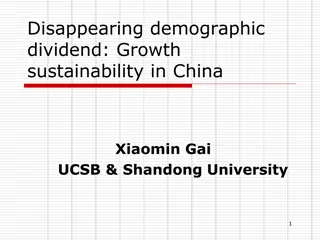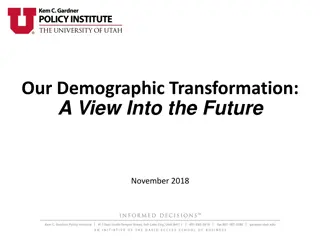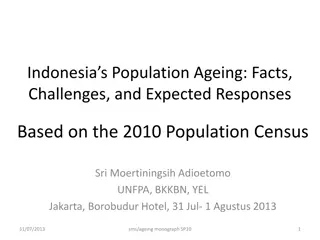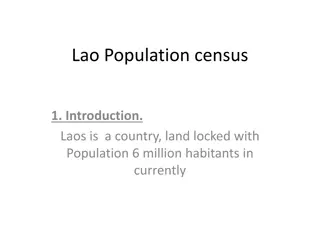Understanding Population Pyramids and Demographic Trends in China
Explore the population pyramids, demographic trends, and economic development stages in China. Discover key features such as gender distribution, age bands, and dependency ratios. Learn about China's historical population data, urbanization rate, and median age. Gain insights into how China's population size, density, and distribution have evolved over time.
Download Presentation

Please find below an Image/Link to download the presentation.
The content on the website is provided AS IS for your information and personal use only. It may not be sold, licensed, or shared on other websites without obtaining consent from the author. Download presentation by click this link. If you encounter any issues during the download, it is possible that the publisher has removed the file from their server.
E N D
Presentation Transcript
Todays lesson we are looking at: 1. Population pyramids 2.Population age and gender 3.Population trends and wealth.
Key features of a population pyramid Name the three features that every population pyramid will have? 1. Gender 2. % of population 3. Age (in 5 year age bands) Old dependents Young dependents Economically active
Stage 1 Stage 2 Stage 3 Stage 4 Expansive. Expansive. Stationary. Contractive. Concave sides. Straight sides. Convex sides. Convex sides. High birth rate. Still high birth rate. Declining birth rate. Low birth rate. High death rate. Falling death rate. Low death rate. Low death rate. Slightly longer life expectancy. Longer life expeactancy. Short life expectancy. Long life expectancy. An increasing proportion of the population is in the 65+ age group. Rapid fall in each upward age group due to high DR. Fall in DR so more people living into middle age. Higher dependency ratio. Amazon Tribes Kenya Argentina Sweden Economic development increases >>>>
The current population of China is 1,380,731,205 (1.38 billion) as of Wednesday, March 30, 2016, based on the latest United Nations estimates. China population is equivalent to 18.72% of the total world population. China ranks number 1 in the list of countries by population. The population density in China is 147 per Km2(381 people per mi2). The total land area is 9,390,784 Km2 (3,625,800 sq. miles) 56.6 % of the population is urban (799,964,410 people in 2016) The median age in China is 37.3 years.
About 94% of China's population lives on approximately 46% of land.
Population of China (2016 and historical) Country's Share of World Pop China Global Rank Yearly % Change Yearly Change Migrants (net) Fertility Rate Density (P/Km ) Urban Pop % Urban Population World Population Year Population Median Age 2016 1,382,323,332 0.46 % 6,274,389 -300,000 37.3 1.56 147 57.9 % 799,964,410 18.6 % 7,432,663,275 1 2015 1,376,048,943 0.52 % 7,016,041 -360,000 37 1.55 147 56.6 % 779,478,624 19.86 % 7,349,472,099 1 2010 1,340,968,737 0.54 % 7,073,621 -440,400 35 1.53 143 49.9 % 669,386,225 20.57 % 6,929,725,043 1 2005 1,305,600,630 0.55 % 7,125,212 -428,800 33 1.5 139 42.9 % 560,517,729 21.31 % 6,519,635,850 1 2000 1,269,974,572 0.68 % 8,426,658 -101,400 30 1.48 135 36.2 % 459,383,108 22.14 % 6,126,622,121 1 1995 1,227,841,281 1.24 % 14,647,102 -164,700 27 2 131 31.2 % 383,155,985 23.12 % 5,735,123,084 1 1990 1,154,605,773 1.87 % 20,396,673 -30,900 25 2.75 123 26.7 % 308,166,890 23.79 % 5,309,667,699 1 1985 1,052,622,410 1.48 % 14,956,995 -51,600 23 2.52 112 23.1 % 242,987,297 23.71 % 4,852,540,569 1 1980 977,837,433 1.55 % 14,451,398 -85,700 22 3.01 104 19.5 % 190,483,105 24.08 % 4,439,632,465 1 1975 905,580,445 2.29 % 19,413,946 -222,600 20 4.85 97 17.6 % 158,961,220 24.59 % 4,061,399,228 1 1970 808,510,713 2.73 % 20,383,953 -2,500 19 6.3 86 17.5 % 141,701,722 24.33 % 3,682,487,691 1 1965 706,590,947 1.86 % 12,428,155 -33,100 22 6.11 64 11.8 % 83,276,451 23.41 % 3,322,495,121 1 1960 644,450,173 1.49 % 9,175,186 -1,600 21 5.48 69 16.4 % 105,426,589 23.36 % 3,018,343,828 1 1955 598,574,241 1.93 % 10,892,264 -33,100 22 6.11 64 13.9 % 83,276,451 23.7 % 2,758,314,525 1
Population Statistics in China According to the 2010 census, the number of people over 60 grew to 13.26 percent of the population, up 2.98 percent from 2000. The number of people under 14 declined to 16 percent of the population, down 6.29 percent from 2000. A census report issued by Beijing attributed the change in age composition to improved health and medicine, low fertility levels and rapid economic development. Nearly two-thirds of the Chinese population (750 million people) is under the age of 35; 92 percent are Han Chinese; and 75 percent (900 million people) are rural peasants or migrants (compared to 40 percent in most developing countries and 20 percent in developed countries).
In the year 2000 Shanghai had a population of 20 million people; Beijing and Tianjin had 15 million each; and seven other cities had a population of more than 5 million each. More than 100 Chinese cities have a population of more than 1 million. In 1949 crude death rates were probably higher than 30 per 1,000, and the average life expectancy was only 32 years. Beginning in the early 1950s, mortality steadily declined; it continued to decline through 1978 and remained relatively constant through 1987. One major fluctuation was reported in a computer reconstruction of China's population trends from 1953 to 1987 produced by the United States Bureau of the Census. The computer model showed that the crude death rate increased dramatically during the famine years associated with the Great Leap Forward, resulting in approximately 30 million deaths above the expected level.
China's population is increasing, even with the controls on family size. What is driving the growth is that hundreds of millions of Chinese are still in their reproductive years. On such a huge base, even one or two children per couple adds large numbers---an effect known as population momentum. The fertility level is expected to drop below replacement level soon. Already the population of Beijing, Shanghai, Tianjin and other cities would be declining were it not for the influx of migrants. Some Chinese demographers hope that China can stabilize its population and then "allow birth control and natural mortality" to reduce the population to 700 million, considered the ideal number for a nation of China's size.
Global Environmental Impact of China's Population Kenneth R. Weiss wrote in the Los Angeles Times, The Chinese are living better overall: consuming more food, energy and goods than ever. One- fourth of the population the equivalent of everyone in the United States has entered the middle class. The U.S. consumes much more per person. But with a population four times larger, China has a greater collective appetite and a greater ecological impact than any other country. [Source: Kenneth R. Weiss, Los Angeles Times, July 22, 2012
Global Environmental Impact of China's Population The compounding forces of economic and population growth are a source of increasing concern to scientists. An international team of 1,300 researchers organized by the United Nations concluded that evidence points to "abrupt and potentially irreversible changes" in ecosystems in the next few decades, including mass extinctions and rapid climate change. How this drama plays out is not merely China's concern. Because of the nation's sheer size, the rest of the world has an enormous stake in the outcome. "To solve China's problems is to solve the world's problems," said Yu Xuejun, a director-general in the country's National Population and Family Planning Commission.
Low Urban Fertility Rate in China The 2010 national census showed that the average birth rate for a Chinese household was 1.181, with the rate lower in cities and higher in rural areas. Some scholars say that number is extraordinarily low, and the real figure is probably a bit higher. According to estimates by the United Nations, the total fertility rate (the average number of children born to a woman in her lifetime) from 2005 to 2010 was 1.63 on average. The Chinese government fertility rate figure was 1.18 in the 2010 census. In urban areas as Beijing and Shanghai, it even dips below 1.0.
Consequences of the lower fertility rate. China faces an urban shift that will shrink the pool of factory workers who sustain economic growth and expand the ranks of the elderly, pushing up health-care and pension costs. Higher education levels, a focus on careers, and greater expectations are causing city- dwellers to marry later and have fewer children. The falling birth rate, exacerbated by China's three- decade- old one-child policy, will cut the number of 15- to 24- year-olds, the mainstay of factories, by 27 percent to 164 million by 2025, the United Nations estimates. In that time, those over the age of 65 will surge 78 percent to 195 million. [Source: Bloomberg News, May 31, 2012]
Consequences of the lower fertility rate. So lower fertility rate = less working age people = increase costs for companies in China, wages increasing, slower expansion of the economy (which has happened).
Problems with population growth With such a huge population, every social problem is magnified. If 10 percent of the population in China is unemployed, for example, the number of people out of work is equal to half the population of the United States. Competition for opportunities is fierce as there are so many people. Over population has caused severe water shortages in places with high rainfall and produced housing shortages in cities where the average person lives in the space the size of a small closet (12 square feet per person). The economy in China is booming in part because 70 percent of the population is of working age. This will change dramatically as the population ages and because of the fact that there are fewer children become adults because of the old child policy.
What do you notice about the projected population structure in China in 2050?
Ageing population.. Another consequence of a low birth rate and one-child policy is an increasingly older population. China's elderly population is growing rapidly while the number of young adults is shrinking, a huge demographic shift that has been building for decades. While the elderly still make up a relatively small share of China's population compared with some Western nations, demographers predict that the proportion of elderly will nearly double from 2008 to 2025. By 2050, they say, one in four Chinese will be 65 or older. The 2010 census shows that people over 60 years of age account for 13.26 percent of the populace, compared to 10.33 percent in 2000. By 2040, this figure is projected to spike to a stunning 28 percent. A 2010 study by the Chinese Academy of Social Sciences (CASS) forecast that by 2030, the proportion of the population that is over 65 will exceed even that of Japan, which has the greyest population in Asia.
The problems associated with an ageing population Less working age people to support the growing elderly population. By 2039, less than two Chinese taxpayers may have to look after one retiree. In Shanghai, people over 60 already make 21.6 percent of the population and are expected to make up 34 percent in 2020. Similar trend are occurring across the country, especially in urban areas where the working- age population is expect to peak in about 2015. The aging situation is likely felt even more in the Chinese countryside due to the ongoing migration of younger, rural-born workers to towns and cities.
The problems associated with an ageing population An aging population means that relatively small group of young people has to economically support a large number of elderly people. Health care and pension costs will soar as elderly people make up a larger portion of the population. There will be a labour shortage as the demands by the elderly exceed the ability to young people to meet them. The ratio of working people to retirees is dropping quickly. Immigrant labour will be needed to make up the shortfall. China is the first nation to have to cope with a population that is getting older before it becomes rich. The elderly population is expected to mushroom before the economy and society have the capability to deal with the problem. Already, China is racking up health care and pension costs it can not afford as people born in the 1950s and 60s begin retiring. By 2035 and 2040 the peak of the aging problem China will face a social security deficient of $128 billion. Despite three decades of dizzying economic growth, rural China remains terribly poor and they will have to cope with the old age burden on vastly lower income levels than Japan or today's greying Western societies Who will care for this looming wave of retirees? Certainly it will not be the country's existing pension system. The pension system in China consists mainly of special arrangements for employees of certain municipalities and state enterprises, and it only covers only a fraction of the country's workforce. The traditional Chinese way has always been for family members to look after their elderly in countryside and city. This support system is much frailer now because of the lower fertility rates.
If China ends up with too many old people and too few young workers it could slow economic growth. In the worst case the government and families will have to tap into savings to take care of the elderly, reducing funds for investments and driving up interest rates. As the working-age population shrinks, labour cost will rise. China's aging population could undermine the advantages of low-cost labour by the middle of the 21st century. In 2007 China had six people in the workforce for every retiree but this ratio while fall to 2:1 by 2050.
http://factsanddetails.com/china/cat4/sub15/ item129.html
